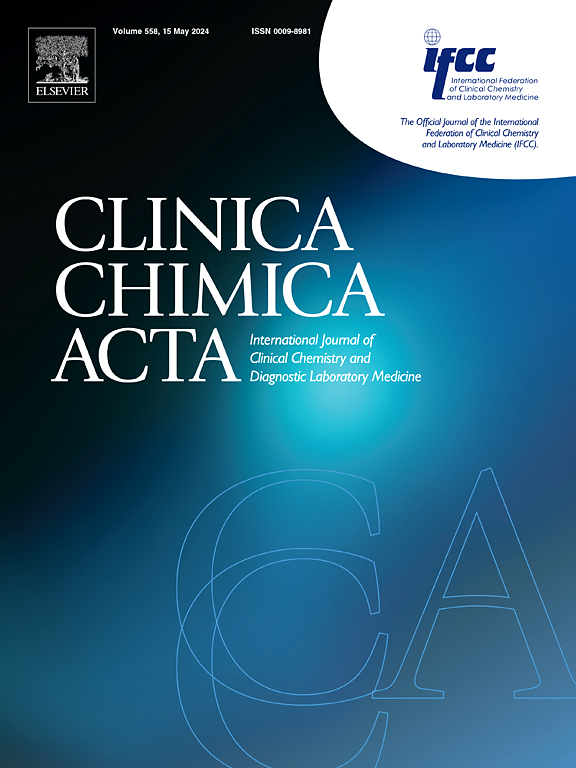Pediatric reference values of VEGF-D derived from a German population-based cohort of healthy children
IF 3.2
3区 医学
Q2 MEDICAL LABORATORY TECHNOLOGY
引用次数: 0
Abstract
Background
Vascular endothelial growth factor D (VEGF-D) is a growth-factor involved in the development of blood vessels and lymphatics in tissues all over the human body. Interestingly, VEGF-D serum levels are increased in certain tumor entities. For tuberous sclerosis complex (TSC), a rare genetic disease associated with (benign) tumor growth, VEGF-D is already implemented as a diagnostic and therapeutic biomarker to monitor onset and progress of lymphangioleiomyomatosis (LAM), one of the noncancerous tumor manifestations in mainly female adult TSC patients.
To date only adult VEGF-D serum cut off values are established and used as a diagnostic tool in LAM.
Neither cut off nor pediatric reference values for VEGF-D serum levels are known, our study aims to provide reliable pediatric VEGF-D results in samples from healthy children and adolescents.
Methods
We analyzed 2003 samples provided by healthy children aged 0.25–18 years participating in the prospective longitudinal population-based cohort study „LIFE Child“ in Leipzig, Germany. Serum VEGF-D levels were measured by enzyme-linked immunoassay.
Results
VEGF-D levels in healthy children and adolescents show age-and gender specific variations.
We showed a significant difference between girls and boys in post pubertal VEGF-D levels. Especially the fact, that girls showed higher VEGF-D levels with advancing stages of puberty is underlining the importance of estrogen metabolism in context of VEGF-D mediated cell proliferation, angiogenesis and associated disease mechanisms.
Conclusion
Knowing VEGF-D levels in growing healthy young children and adolescents could help to recognize early disease progression of LAM in individuals at risk especially young women suffering from TSC. Further studies are needed on VEGF-D serum levels in children, especially the impact of estrogen metabolism on VEGF-D should be investigated further.
VEGF-D的儿科参考值来自一项基于德国人群的健康儿童队列
血管内皮生长因子D (VEGF-D)是一种参与人体组织中血管和淋巴管发育的生长因子。有趣的是,VEGF-D血清水平在某些肿瘤实体中升高。结节性硬化症(TSC)是一种罕见的与(良性)肿瘤生长相关的遗传疾病,VEGF-D已经作为一种诊断和治疗性生物标志物,用于监测淋巴管平滑肌瘤病(LAM)的发病和进展,LAM是主要发生在女性成年TSC患者中的一种非癌性肿瘤表现。迄今为止,只有成人VEGF-D血清切断值被建立并用作LAM的诊断工具。目前还不知道VEGF-D血清水平的截断值和儿童参考值,我们的研究旨在为健康儿童和青少年样本提供可靠的儿童VEGF-D结果。方法我们分析了2003例来自德国莱比锡的25 - 18岁健康儿童的样本,这些儿童参加了前瞻性纵向人群队列研究“LIFE Child”。采用酶联免疫分析法测定血清VEGF-D水平。结果健康儿童和青少年vegf - d水平存在年龄和性别差异。我们发现女孩和男孩在青春期后VEGF-D水平上有显著差异。特别是,随着青春期的推进,女孩显示出更高的VEGF-D水平,这一事实强调了雌激素代谢在VEGF-D介导的细胞增殖、血管生成和相关疾病机制中的重要性。结论了解生长健康儿童和青少年的VEGF-D水平有助于识别高危人群尤其是年轻女性TSC患者LAM的早期疾病进展。儿童血清VEGF-D水平有待进一步研究,尤其是雌激素代谢对VEGF-D的影响有待进一步研究。
本文章由计算机程序翻译,如有差异,请以英文原文为准。
求助全文
约1分钟内获得全文
求助全文
来源期刊

Clinica Chimica Acta
医学-医学实验技术
CiteScore
10.10
自引率
2.00%
发文量
1268
审稿时长
23 days
期刊介绍:
The Official Journal of the International Federation of Clinical Chemistry and Laboratory Medicine (IFCC)
Clinica Chimica Acta is a high-quality journal which publishes original Research Communications in the field of clinical chemistry and laboratory medicine, defined as the diagnostic application of chemistry, biochemistry, immunochemistry, biochemical aspects of hematology, toxicology, and molecular biology to the study of human disease in body fluids and cells.
The objective of the journal is to publish novel information leading to a better understanding of biological mechanisms of human diseases, their prevention, diagnosis, and patient management. Reports of an applied clinical character are also welcome. Papers concerned with normal metabolic processes or with constituents of normal cells or body fluids, such as reports of experimental or clinical studies in animals, are only considered when they are clearly and directly relevant to human disease. Evaluation of commercial products have a low priority for publication, unless they are novel or represent a technological breakthrough. Studies dealing with effects of drugs and natural products and studies dealing with the redox status in various diseases are not within the journal''s scope. Development and evaluation of novel analytical methodologies where applicable to diagnostic clinical chemistry and laboratory medicine, including point-of-care testing, and topics on laboratory management and informatics will also be considered. Studies focused on emerging diagnostic technologies and (big) data analysis procedures including digitalization, mobile Health, and artificial Intelligence applied to Laboratory Medicine are also of interest.
 求助内容:
求助内容: 应助结果提醒方式:
应助结果提醒方式:


